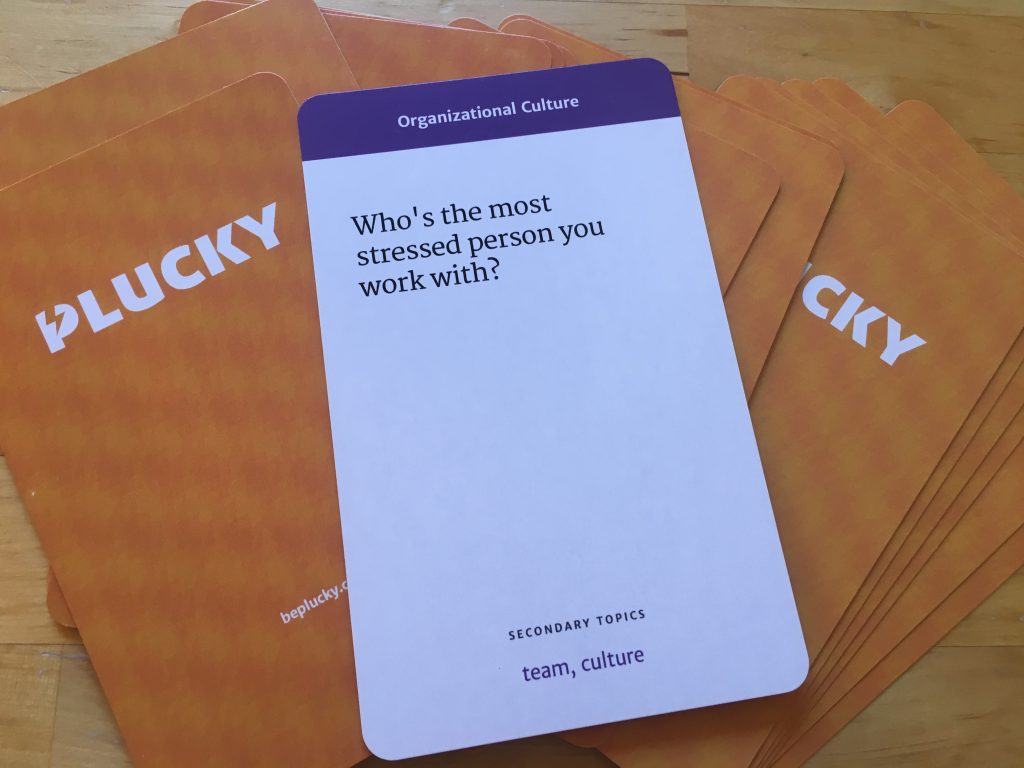tldr; We recently celebrated the two-year anniversary of Plucky’s first product, a tool for managers to elevate the conversations happening in 1:1s. To date, we have sold 650+ packs. You can check out the 1:1 starter pack here.

Who’s the most stressed person you work with? The question hangs in the air. Maybe it seems like the conversation will be short, the name of one colleague. But I want to show you how this simple question can bring up tons of insight about your report, the team, the company and your own performance.
Scenario 1: the Quick Answer
“Oh that’s an easy one. Clearly Max!”
If your report responds easily without hesitation, we can assume there is some EQ going on. (HOO.RAY.) This person has thought about the world from Max’s point of view, observed Max’s behavior and this knowledge is front of mind.
Invite this report to explain how they know Max is stressed. Have a conversation about Max’s workload, transitions that may be happening in his work life, relevant personal details that he’s shared with the team. Your report is giving you gold in terms of perspective; they can see aspects of Max’s work that you don’t normally have access to. Wonder together how you might support Max through his stress.
If Max’s name comes up in multiple 1:1s, you have an employee whose stress is affecting the team. Whether you remove work from his plate, share tactics to manage stress or remind him that he doesn’t have to be perfect, your responsibility is to support. Suit up and use your role to help.
Side note: if everyone is naming Max and you had no idea Max was stressed, you’ve been missing something! Time to listen closer.
Scenario 2: the Guess
“I have no idea. Maybe Sarah? She IS the CEO…”
First, ask a couple follow-ups; some reports need a minute to process the question. Have you noticed anyone staying later? Anyone skipping lunch? Anyone having a short fuse? This might inspire a name.
If they truly don’t have insight into other folks, your report may offer what they believe is a logical answer. They will look for someone on the org chart who seems busy. Like the CEO!
Take this opportunity to push them a little, help them practice empathy. Acknowledge that they’re probably right, CEOs are always busy, but wonder with them why the CEO is particularly stressed lately. Talk about your observations — does CEO Sarah skip meetings more often when things are busy? Segway into a conversation about how you handle your stress. Ask your report about their own practices to keep stress in check.
Your job is not to turn this person into a highly-empathetic individual. But as a manager, you can model perspective and value empathetic awareness of team members by keeping the conversation alive, even for a few minutes.
Scenario 3: the Ask for Help
“Am I allowed to say myself?”
Jackpot. This self-aware report has just gifted you an opportunity to coach. You ready?
First let them spill the stress, say all the things. Use a whiteboard or notebook to make a giant list of all stresses.
Stressed-out people are, quite simply, stuck. They often lack the ability to prioritize and act — an overwhelming momentum swallows them. As the manager, you can gently help them re-see and take a breath.
Identify patterns in the stress. Maybe draw circles around everything that’s related to Project A at work. Draw squares around non-work obligations. Use color. Now sit back and look at this messy picture together. Ask:
- What can you delegate?
- What’s most important on this list? What’s least important?
- How can I help?
Reports will let you in, to varying degrees. There is no template for this conversation. But offering help and demonstrating a willingness to problem solve with them is a great start.
Note: maybe this is not a new problem for this report. Maybe they are always stressed. As their manager, practice patience and drop the bar for perfectionism as often as possible. But I have some hard news for you, too. People who continuously hide behind stress are not good long-term team members. They are using stress to distract from something larger. They may need outside help in order to get things under control and do their best work.
Who is the most stressed person you work with? This question is simple but the answers it inspires can be complex and fascinating. Humans are like this, always giving you invisible data, from the tone of voice they use to what they leave unsaid.
You can manage at face value. Or you can learn to listen to this invisible data and create powerful change for the team. The only way to get better at this stuff is to practice — so pull this card from your pack, schedule some 1:1s and get to work.
P.S. We truly love hearing about how these conversations are going. Send me stories, failures or complete victories! We love ’em all.
P.P.S. Here’s more guidance on using your #PluckyCards:
Want to hear more from me about the way we work? Sign up for Plucky’s monthly newsletter here.